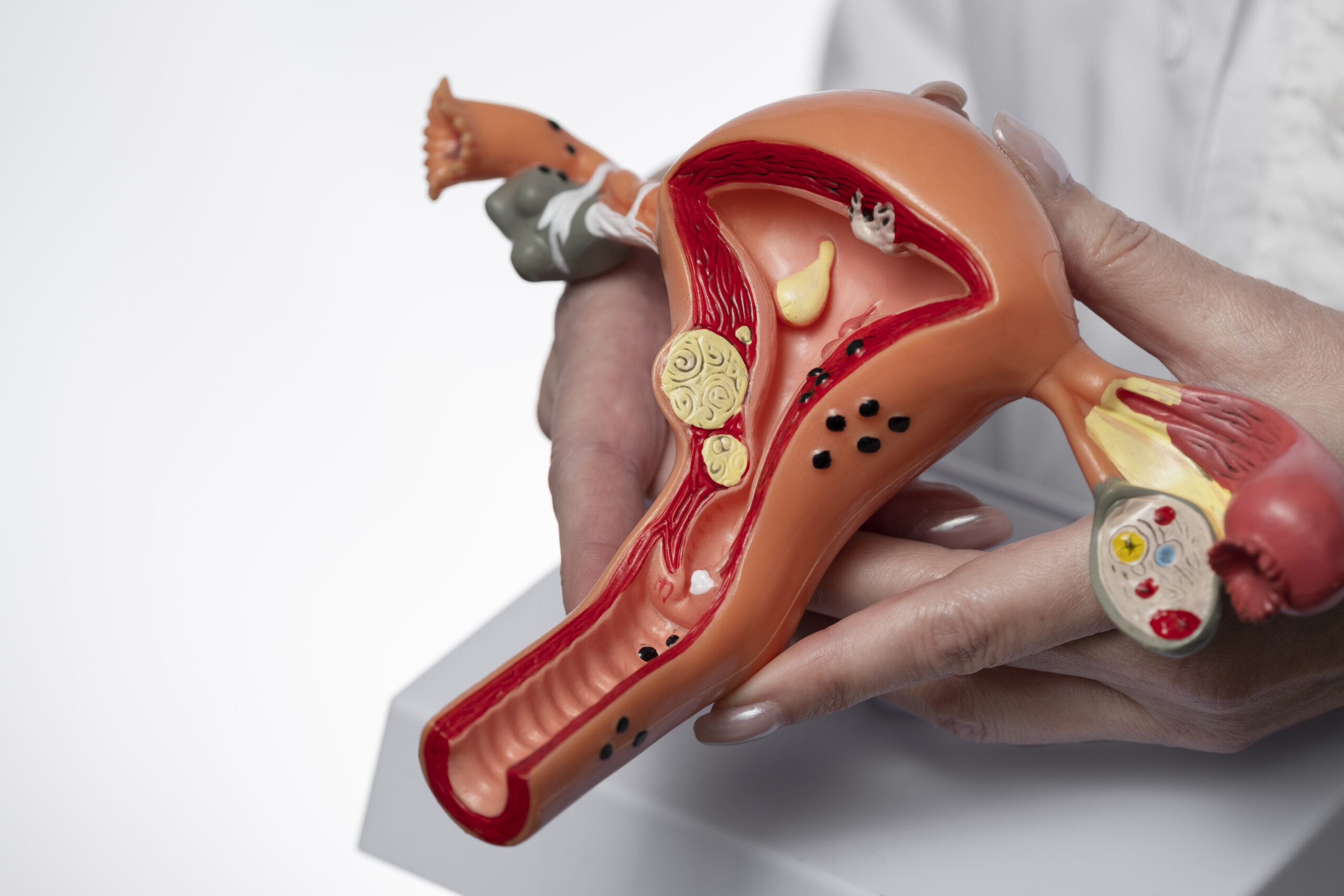Ovarian cysts are a group of various lesions found in the ovaries and the female internal reproductive organs. Most often, these changes are not dangerous to the woman's life and health, but after their diagnosis, they often cause anxiety among patients who come to the gynecologist.
An ovarian cyst is a sac-like, usually spherical space surrounded by a wall filled with liquid content. Cysts may occur singly or in multiples, in one or both ovaries.
The most common ovarian cyst![]() is a simple cyst, a functional or follicular cyst
is a simple cyst, a functional or follicular cyst![]() . It contains uniform, transparent content inside. It occurs due to hormonal disorders occurring in the cycle before ovulation. In a cycle, after menstruation, follicles appear in the ovaries, one of which becomes the dominant follicle, which, after reaching a diameter of approximately 2 cm, has the opportunity to release an egg cell under the influence of the release of LH (luteinizing hormone) and FSH (follicle-stimulating hormone) hormones. If it does not rupture, its size increases, and the follicle becomes a simple cyst.
. It contains uniform, transparent content inside. It occurs due to hormonal disorders occurring in the cycle before ovulation. In a cycle, after menstruation, follicles appear in the ovaries, one of which becomes the dominant follicle, which, after reaching a diameter of approximately 2 cm, has the opportunity to release an egg cell under the influence of the release of LH (luteinizing hormone) and FSH (follicle-stimulating hormone) hormones. If it does not rupture, its size increases, and the follicle becomes a simple cyst.
The second, quite common cyst is the corpus luteum cyst![]() , which occurs due to abnormal disappearance of the corpus luteum. It appears in the second phase of the cycle and may result from too high progesterone concentration after ovulation. It usually reaches a size of 4-6 cm. Sometimes, the corpus luteum, necessary for embryo development at the beginning of pregnancy, is mistakenly called a cyst.
, which occurs due to abnormal disappearance of the corpus luteum. It appears in the second phase of the cycle and may result from too high progesterone concentration after ovulation. It usually reaches a size of 4-6 cm. Sometimes, the corpus luteum, necessary for embryo development at the beginning of pregnancy, is mistakenly called a cyst.
Although most ovarian cysts are harmless, each requires regular check-ups with a gynecologist. It is justified by the fact that atypical, complex cysts – cancerous – may appear in the ovaries. They may be highly vascularized and contain tissues extending inside the lesion. They do not disappear on their own, sometimes grow in too large sizes, and maybe are multi-chambered.

Pathological cysts![]() are unrelated to the ovaries' function and require observation and extended diagnostics. Such cysts include:
are unrelated to the ovaries' function and require observation and extended diagnostics. Such cysts include:
Endometrial cysts![]() form during endometriosis, a disease in which fragments of the uterine mucosa implant into the tissues of the ovaries, fallopian tubes, and peritoneal cavity. They may be called “chocolate cysts” because they are filled with a characteristic dark brown content originating from shed cells of the mucous membrane and blood.
form during endometriosis, a disease in which fragments of the uterine mucosa implant into the tissues of the ovaries, fallopian tubes, and peritoneal cavity. They may be called “chocolate cysts” because they are filled with a characteristic dark brown content originating from shed cells of the mucous membrane and blood.
Dermoid cysts![]() are a benign type of ovarian cancer – mature teratoma originating from multipotential ovarian germ cells. Cysts may contain hair, sebaceous glands, sweat glands, and sometimes teeth and nails. Most of them are detected accidentally in young patients. The lesions grow slowly but can become large.
are a benign type of ovarian cancer – mature teratoma originating from multipotential ovarian germ cells. Cysts may contain hair, sebaceous glands, sweat glands, and sometimes teeth and nails. Most of them are detected accidentally in young patients. The lesions grow slowly but can become large.
Cysts detected in the course of PCOS![]() by ultrasound examination give an image of numerous small cysts. The ovary is enlarged, and the patient struggles with hormonal disorders:
by ultrasound examination give an image of numerous small cysts. The ovary is enlarged, and the patient struggles with hormonal disorders:
Mucinous or serous cystadenomas![]() are benign tumors of epithelial origin. Differentiating cystadenomas from malignant lesions includes imaging tests, histopathology, and determination of CA125 and HE4 markers in the blood with the simultaneous statistical calculation of the ROMA index
are benign tumors of epithelial origin. Differentiating cystadenomas from malignant lesions includes imaging tests, histopathology, and determination of CA125 and HE4 markers in the blood with the simultaneous statistical calculation of the ROMA index![]() (risk of ovarian malignancy algorithm) from these parameters. ROMA is an algorithm that assesses the chance of ovarian cancer, i.e., the probability that the detected cyst is malignant.
(risk of ovarian malignancy algorithm) from these parameters. ROMA is an algorithm that assesses the chance of ovarian cancer, i.e., the probability that the detected cyst is malignant.
Cancer cysts![]() may appear in ovarian cancer (epithelial cell cancer), germ cell tumors, gonadal tumors (hormone-secreting tumors), and in the case of metastases of other cancers to the ovary (mainly from the digestive system). However, malignant lesions usually form masses of cells forming a solid tumor, and less often, they appear as fluid-filled cysts.
may appear in ovarian cancer (epithelial cell cancer), germ cell tumors, gonadal tumors (hormone-secreting tumors), and in the case of metastases of other cancers to the ovary (mainly from the digestive system). However, malignant lesions usually form masses of cells forming a solid tumor, and less often, they appear as fluid-filled cysts.
The ovaries![]() , or female gonads, are part of the internal components of the female reproductive system. Physiologically, they occur as a paired organ located in the pelvis. The ovary has a volume of approximately 6–8 ml.
, or female gonads, are part of the internal components of the female reproductive system. Physiologically, they occur as a paired organ located in the pelvis. The ovary has a volume of approximately 6–8 ml.
The ovaries, the critical female reproductive organs for human fertility, are located in pairs within the pelvis's peritoneal cavity on the side wall. They are located between the rectum and the broad ligaments of the uterus, to which short mesenteries attach them.
This place is called the ovarian fossa and is located in the branching of the common iliac artery into two branches – external and internal. At the top, each ovary is connected to the fallopian tubes, approximately 10-centimeter tubes leading to the uterus, and used to transport mature eggs.
The position of the ovaries may be slightly variable, but two ligaments ensure their stabilization.
Ovarian functions are inextricably linked with human reproduction. These organs, which are the female equivalent of male testicles, fulfill two tasks in the human body:
Almost every woman will develop a cyst in her ovaries during her life, which may be visible in an ultrasound examination during a routine visit to a gynecologist. Most of them do not require treatment.
In most cases, ovarian cysts do not cause symptoms![]() . Women who have had inflammation of the reproductive organs and surrounding structures in the past or who have had gynecological or abdominal surgery that resulted in adhesions may experience discomfort in the lower abdomen.
. Women who have had inflammation of the reproductive organs and surrounding structures in the past or who have had gynecological or abdominal surgery that resulted in adhesions may experience discomfort in the lower abdomen.
Symptoms of larger cysts depend on their size. The larger the cyst, the greater the likelihood that a woman will experience lower abdominal pain and menstrual cycle disorders in the form of irregular bleeding and intermenstrual spotting. In some cases, there may be pain during intercourse or pressure on the bladder, resulting in more frequent visits to the toilet. Some types of cysts cause problems with getting pregnant.
The first symptom of large lesions may be related complications – a twist or rupture, usually felt as severe pain located in the lower abdomen. It may be accompanied by nausea, vomiting, weakness, and fainting.

An ovarian cyst is typically discovered accidentally during an annual visit to the gynecologist's office. Detected symptomatic and asymptomatic ovarian cysts should be monitored regularly, and most do not require treatment. Suppose a woman has an ovarian cyst and suddenly severe pain in the lower abdomen appears, which may also be accompanied by nausea and vomiting. In that case, she should immediately see a doctor.
During a transvaginal ultrasound examination, ovarian cysts are usually detected in a gynecologist's office. Thanks to it, it is possible to measure the size of the lesion and determine its shape, content, and the presence of partitions. The additional Doppler function enables imaging of the cyst's vascularization. Selecting the features of the lesion visible in the ultrasound examination allows for the preliminary exclusion or suspicion of a cyst requiring treatment or implementation of extended diagnostics for malignant tumors.
To exclude the diagnosis of cancer, the doctor orders laboratory blood tests – ROMA and CA125 tests![]() , especially in postmenopausal women. Please remember that increased CA125 levels may also indicate other diseases. Sometimes it is necessary to perform additional imaging tests
, especially in postmenopausal women. Please remember that increased CA125 levels may also indicate other diseases. Sometimes it is necessary to perform additional imaging tests![]() – magnetic resonance imaging (MRI) or computed tomography (CT) of the pelvis.
– magnetic resonance imaging (MRI) or computed tomography (CT) of the pelvis.
The treatment![]() of ovarian cysts depends on their type and size, the patient's age, and the symptoms they cause. Simple cysts usually do not require treatment and often disappear spontaneously within a few cycles. More significant, numerous, or persistently recurrent and symptomatic cases may require the use of hormonal contraception.
of ovarian cysts depends on their type and size, the patient's age, and the symptoms they cause. Simple cysts usually do not require treatment and often disappear spontaneously within a few cycles. More significant, numerous, or persistently recurrent and symptomatic cases may require the use of hormonal contraception.
Surgical treatment is reserved for lesions larger than 5-7 cm, symptomatic lesions, or atypical cysts with a high probability of cancer. Depending on the size and possible need to extend the procedure. The laparoscopic method is less invasive and involves enucleation and removal of the lesion through three holes in the abdominal wall using special tools. The open approach involves opening the abdominal wall and performing the procedure through an incision in the lower abdomen or its transverse dimension. Suspicious lesions with a high risk of cancer may require removal of the entire reproductive organ.
In case of complications of large ovarian cysts, such as torsion or sometimes rupture of the lesion, urgent surgery is usually necessary, which may result in the removal of the ovary.
In most cases, small cysts are absorbed independently, leaving no trace behind. Unfortunately, during the reproductive period, the changes may recur, especially in the case of hormonal imbalance. Removal usually leads to their complete cure. The situation is different in the case of endometriosis or cancerous cysts other than teratoma, which may require long-term therapy and will not always lead to a complete cure.
After completing treatment for ovarian cysts, regular check-ups scheduled by a gynecologist are always necessary. The frequency of visits is selected individually, depending on the nature of the change and any ailments.
Functional ovarian cysts, also known as simple cysts, are the most common ovarian cysts. Their formation is related to the woman's hormonal balance disruption, which results in irregular cycles. Sometimes, bleeding may occur on the expected date of menstruation, but such a cycle is anovulatory. Ovulation does not occur, and the ovum retained in the ovary – the Graafian follicle – does not burst, even though it has reached a large size. This follicle transforms into a follicular cyst. Lack of an egg means you can't get pregnant![]() .
.

Another type of functional ovarian cyst is a transformed corpus luteum cyst. In this case, there is ovulation, but the corpus luteum does not atrophy despite the lack of fertilization. Functional cysts are usually spontaneously resorbed in the next cycle. They rarely require hormonal treatment; in this case, several months of therapy with contraceptive pills leads to their disappearance.
Endometriosis is a disease of unknown cause in which the endometrial lining of the uterus appears in places other than the uterine cavity – in the abdominal cavity, fallopian tubes, and ovaries. One of the concepts behind its development is the theory of the reverse flow of menstrual blood from the uterine cavity through the fallopian tubes to the abdominal cavity. An endometrial cyst has a characteristic ultrasound image filled with hypoechoic, turbid fluid.
The content of these ovarian cysts is blood, and because of their dark color, which is visible when such a cyst is cut open, they are called “chocolate cysts.” An endometrial ovarian cyst may make it difficult to get pregnant, primarily because abnormal endometrial tissue is probably also present in other unusual places. It may cause difficult ovulation and egg transport (fallopian tube obstruction). The first-line treatment for endometrial cysts is surgery, usually laparoscopy. Such a cyst should be removed, sparing the ovarian tissue, and other foci of endometriosis should be looked for in the pelvic cavity.
Polycystic ovary syndrome is a very common endocrinopathy or hormonal disorder. The cause is disturbances in the ratio of FSH to LH hormones (both are pituitary hormones that regulate the functioning of the ovary). Many patients develop insulin resistance and are overweight or obese. Some women report excessive body hair related to increased testosterone levels. Due to hormonal disorders, severe menstrual cycle disorders occur, with infrequent periods. Sometimes, we experience secondary amenorrhea (lack of bleeding for more than three cycles). Women with PCOS rarely ovulate, and their ovaries are filled with small, numerous cysts that have not ruptured. These cysts become fibrotic after some time, and the ovarian volume increases.
Polycystic ovary syndrome PCOS can make it difficult to get pregnant. Treatment involves attempting to induce ovulation hormonally – usually starting with six months of c********e citrate therapy. When such treatment is ineffective, the patient is referred to surgery, usually performed laparoscopy. The goal is to remove excess non-functional ovarian tissue through the so-called wedge resection or electrocautery (burning 3–10 cavities in the ovarian tissue). This action facilitates the return to regular ovulatory cycles and increases the chance of getting pregnant.
Ovarian dermoid cyst is the common name for a benign ovarian tumor, such as a mature teratoma. It is a cancer of stem cells that, for an unknown reason, transform into fat, bone, hair, dental tissue, etc. The name dermoid cyst comes from the thick wall surrounding the cyst. It is the most common ovarian cancer in young girls and women. When they secrete hormones, they can significantly disrupt menstrual cycles and make it difficult to get pregnant. Teratomas are treated surgically, laparoscopically, or openly (laparotomy).
Some doctors immediately decide to perform an open procedure due to the minimal, but always present, risk of the cyst being malignant. Currently, however, there is a trend to operate laparoscopically and, in the case of a malignant cyst detected during intraoperative examination, to perform the so-called conversion to laparotomy. The prognosis for the most common mature teratomas is good.